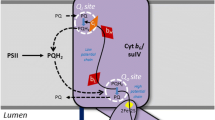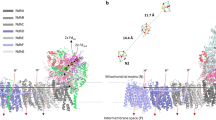Abstract
The H+-ATPase of thylakoids catalyzes ATP synthesis and, in some conditions, hydrolysis in a manner that is linked to proton fluxes. The H+-ATPase consists of two readily separable parts: coupling factor 1 (CF1), a hydrophilic, multisubunit enzyme that is extrinsic to the membrane, and F0, a collection of more hydrophobic proteins that are intrinsic to the membrane. CF1 contains the active sites of the H+-ATPase and is composed of five different subunits, labeled α-ε in order of decreasing molecular weight. F0 constitutes a proton channel and provides specific sites for the attachment of CF1 to the membrane.
Access this chapter
Tax calculation will be finalised at checkout
Purchases are for personal use only
Preview
Unable to display preview. Download preview PDF.
Similar content being viewed by others
References
Akey CW, Crepeau RH, Dunn SD, McCarty RE and Edelstein SJ (1983) Electron microscopy and single molecule averaging of subunit-deficient F1-ATPases from Escherichia coli and spinach chloroplasts, EMBO Jour, in press.
Andreo CS, Patrie WJ and McCarty RE (1982) Effect of ATPase activation and the d subunit of coupling factor 1 on reconstitution of photophosphorylation, J. Biol. Chem. 257, 9968–9975.
Arana JL and Vallejos RH (1982) Involvement of sulfhydryl groups in the activation mechanism of the ATPase activity of chloroplast coupling factor 1, J. Biol. Chem. 257, 1125–1127.
Avron M (1978) Energy transduction in photophosphorylation, FEBS Lett. 96, 225–232.
Béliveau R, Moroney JV and McCarty RE (1982) Endogenous fluorescence of coupling factor 1 from spinach chloroplasts, Arch. Biochem. Biophys. 214, 668–674.
Davenport JW (1983) The coupling of proton translocation to ATP synthesis and hydrolysis by chloroplast thylakoid membranes, Ph.D. Thesis, Cornell University.
Davenport JW and McCarty RE (1981) Quantitative aspects of adenosine triphosphate-driven proton translocation in spinach chloroplast thylakoids, J. Biol. Chem. 256, 8947–8954.
Dunn SD and Futai M (1980) Reconstitution of a functional coupling factor from the isolated subunits of Escherichia coli F1 ATPase, J. Biol. Chem. 255, 113–118.
Farron F (1970) Isolation and properties of a chloroplast coupling factor and heat-activated adenosine triphosphatase, Biochemistry 9, 3823–2828.
Handgarter RP and Good NE (1982) Energy thresholds for ATP synthesis in chloroplasts, Biochim. Biophys. Acta 681, 397–404.
Haraux F, Sigalat C, Moreau A and de Kochkovsky Y (1983) The efficiency of energized protons for ATP synthesis depends on the membrane topography in thylakoids, FEBS Lett. 155, 248–251.
McCarty RE and Portis AR Jr (1976) A simple, quantitative approach to the coupling of photophosphorylation in terms of proton fluxes, Biochemistry 15, 5110–5114.
Merchant S, Shaner SL and Selman BR (1983) Molecular weight and subunit stoichiometry of the chloroplast coupling factor one from Chlamydomonas reinhardii, J. Biol. Chem. 258, 1026–1031.
Mills JD and Mitchell P (1982) Thiol modulation of CF0-CF1 stimulates acid/base-dependent phosphorylation of ADP by broken pea chloroplasts, FEBS Lett. 144, 63–67.
Moroney JV, Lopresti, L, McEwen BF, McCarty RE and Hammes GG (1983) The molecular weight of chloroplast coupling factor 1, FEBS Lett., in press.
Moroney JV and McCarty RE (1982) Light-dependent cleavage of the γ subunit of coupling factor 1 by trypsin causes activation of Mg2+-ATPase activity and uncoupling of photophosphorylation in spinach chloroplasts, J. Biol. Chem. 257, 5915–5920.
Moroney JV, Warncke K and McCarty RE (1982) The distance between thiol groups in the γ subunit of coupling factor 1 influences the proton permeability of thylakoid membranes, J. Bioenerg. Biomembr. 14, 347–359.
Nalin CM, Béliveau R and McCarty RE (1983) Selective modification of coupling factor 1 in spinach chloroplast thylakoids by a fluorescent maleimide, J. Biol. Chem. 258, 3376–3381.
Nelson N and Eytan E (1979) Approach to the membrane sector of the chloroplast coupling device. In Mukohata Y and Packer L, eds. Cation flux across biomembranes, pp 409–415. New York: Academic Press.
Portis AR Jr, Magnusson RP and McCarty RE (1975) Conformational changes in coupling factor 1 may control the rate of electron flow in spinach chloroplasts. Biochem. Biophys. Res. Commun., 64, 877–884.
Portis AR Jr and McCarty RE (1974) Effects of adenine nucleotides and of photophosphorylation on H+ uptake and the magnitude of the H+ gradient in illuminated chloroplasts, J. Biol. Chem. 249, 6250–6254.
Senior AE and Wise JG (1983) The proton-ATPase of bacteria and mitochondria, J. Membr. Biol. 73, 105–124.
Author information
Authors and Affiliations
Editor information
Editors and Affiliations
Rights and permissions
Copyright information
© 1984 Springer Science+Business Media Dordrecht
About this chapter
Cite this chapter
Carty, R.E.M. et al. (1984). Protons, Thiols and Coupling Factor 1 in Relation to Photophosphorylation. In: Sybesma, C. (eds) Advances in Photosynthesis Research. Advances in Agricultural Biotechnology, vol 2. Springer, Dordrecht. https://doi.org/10.1007/978-94-017-6368-4_83
Download citation
DOI: https://doi.org/10.1007/978-94-017-6368-4_83
Publisher Name: Springer, Dordrecht
Print ISBN: 978-90-247-2943-2
Online ISBN: 978-94-017-6368-4
eBook Packages: Springer Book Archive




